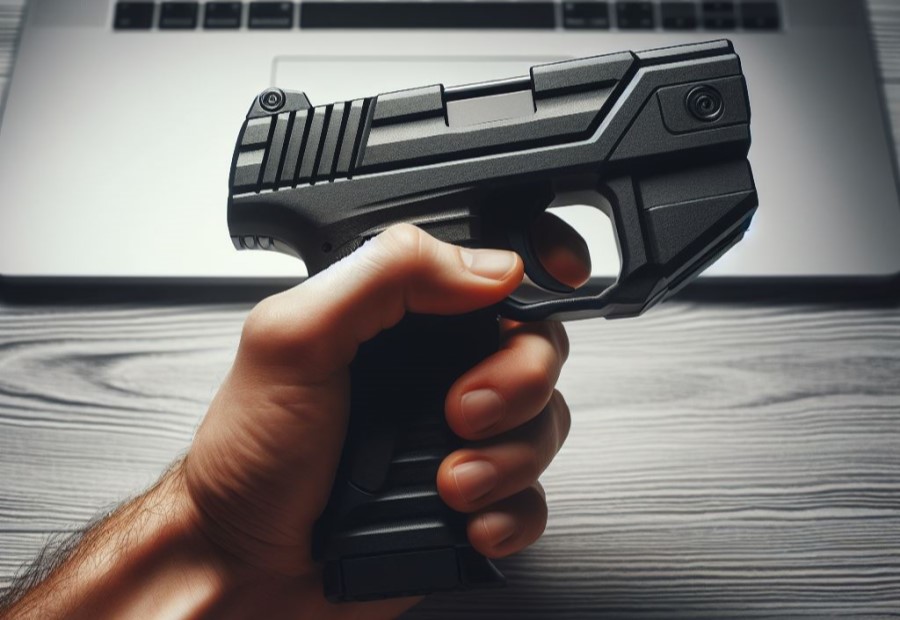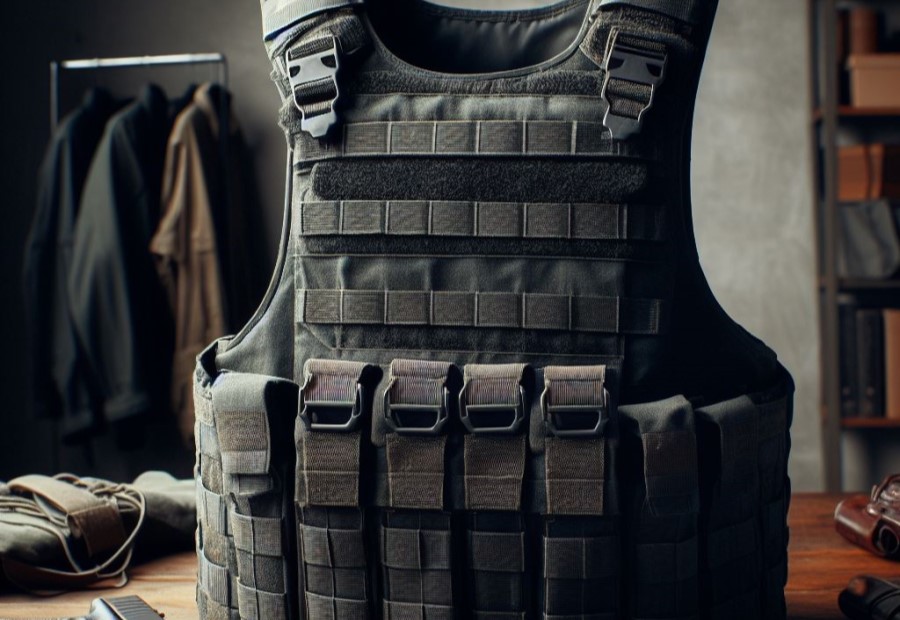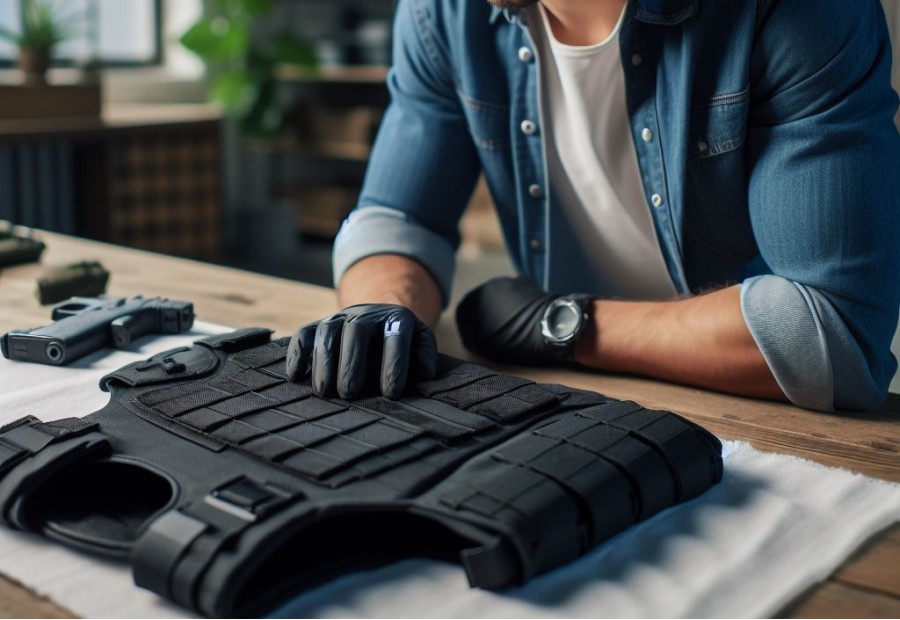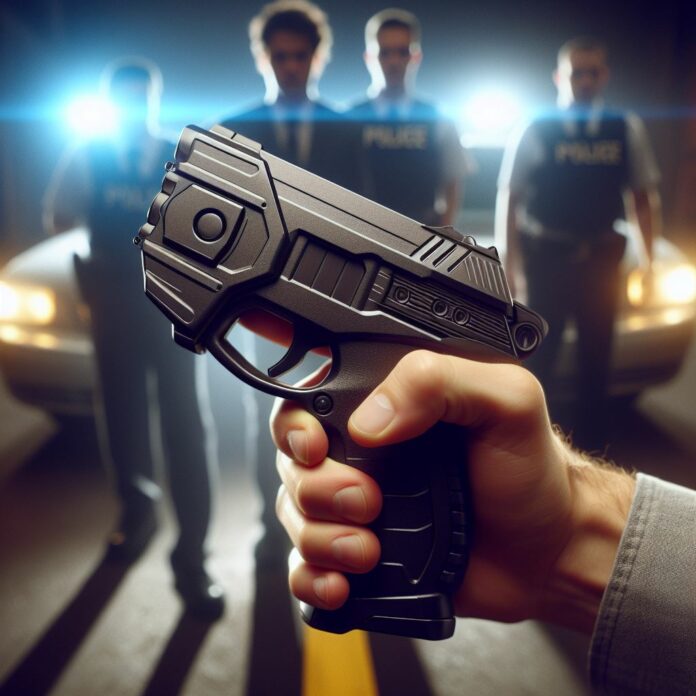Can a bulletproof vest stop a taser? Bulletproof vests and tasers are both protective tools commonly used by law enforcement and security personnel. Understanding how these items work is essential in determining whether a bulletproof vest can stop a taser.
Bulletproof vests are designed to provide protection against firearm projectiles and other ballistic threats. They work by dispersing the force of the impact and preventing the penetration of the bullet into the body.
While bulletproof vests are effective at stopping bullets, their ability to protect against taser shocks is limited.
The electrical current produced by a taser can still penetrate the layers of the vest and reach the wearer’s body, although the impact may be somewhat reduced. Consequently, the vest may not fully prevent the effects of a taser shock.
Several factors influence the effectiveness of a bulletproof vest against a taser. The type of bulletproof vest used, the specific model and design, the type of taser being employed, and the distance and angle of the taser shot are all crucial considerations.
These factors determine the level of protection the vest can provide against electrical shocks.
Understanding Bulletproof Vests

Understanding bulletproof vests is essential when it comes to personal protection. These vests are made of strong materials, such as Kevlar or other ballistic fibers, that can withstand bullets fired from firearms.
They are designed to absorb and disperse the impact of the bullets, reducing the risk of injury or death.
Bulletproof vests come in different levels of protection, ranging from Level I to Level IV, with each level providing varying degrees of protection against different types of ammunition.
Understanding bulletproof vests can help individuals make informed decisions about their personal safety.
Whether it is for law enforcement officers, military personnel, or civilians in high-risk professions, having knowledge about the capabilities and limitations of bulletproof vests is crucial for personal protection.
How do Bulletproof Vests Work?
Bulletproof vests work by using multiple layers of high-strength fibers such as Kevlar or Dyneema. These fibers are tightly woven together to create a strong and flexible material that can withstand the impact of bullets.
When a bullet hits the vest, the fibers absorb and disperse the energy, preventing the bullet from penetrating the body.
The layers of fibers in the vest are designed to slow down the bullet and spread its force over a larger area.
This reduces the likelihood of the bullet piercing through the vest. The fibers also work to deform the bullet, causing it to lose its shape and further dissipate its energy.
The design and construction of the vest play a crucial role in its effectiveness. The vests are typically fitted with additional protective plates made of materials like ceramic or metal to provide extra defense against bullets.
It is important to note that while bulletproof vests are highly effective in stopping bullets, they are not impenetrable.
The level of protection offered by a vest depends on its rating, which indicates the type and caliber of bullets it can stop. Different vests are designed to withstand different levels of ballistic threats.
What are Bulletproof Vests Made of?
Bulletproof vests are made of several layers of strong and durable materials. These materials, such as nylon or Kevlar, are carefully chosen to provide the maximum level of protection against bullets and other projectiles.
The main components of bulletproof vests include:
- Outer Shell: Bulletproof vests are typically made of a strong synthetic fabric such as nylon or Kevlar. The outer shell helps to distribute the force of impact and prevent the penetration of bullets.
- Ballistic Panels: These panels are the most important part of a bulletproof vest. They are made of multiple layers of tightly woven fibers, such as Kevlar or Dyneema, which are highly resistant to tearing and can stop bullets in their tracks.
- Trauma Pad: Some bulletproof vests come with a trauma pad to further enhance protection. This pad, made of foam or cushioning materials, is placed behind the ballistic panels to absorb and disperse the impact force, reducing the risk of injury.
It is important to note that the specific materials used in bulletproof vests may vary depending on the level of protection required and the manufacturer. Different combinations of fibers and weaves can achieve different levels of resistance to bullets.
Understanding Tasers

Tasers are electroshock weapons that are commonly used by law enforcement agencies. Understanding tasers is essential to comprehend their purpose, effects, and use in law enforcement.
They work by delivering electric currents through electrodes that are attached to the device. When the electrodes make contact with a person’s body, the electric shock causes muscle contractions and can temporarily incapacitate them.
It is important to understand how tasers work in order to comprehend their effects and potential risks.
One key aspect of understanding tasers is recognizing that they are primarily used for their incapacitating effects rather than their lethality. Tasers are designed to temporarily disable individuals without causing permanent harm or injury.
The electric shock they deliver can disrupt a person’s nervous system, causing muscle spasms and rendering them immobile for a short period of time.
Furthermore, tasers have been widely adopted by law enforcement agencies as a non-lethal alternative to firearms. They are typically used in situations where officers need to subdue a potentially dangerous suspect without resorting to deadly force.
Tasers are equipped with safety features that minimize the risk of causing serious harm or excessive pain.
A historical example of the use of tasers is its widespread deployment in law enforcement agencies throughout the United States since the early 2000s.
The adoption of tasers has been justified by their effectiveness in reducing officer-involved shootings and minimizing the risk of serious injuries during encounters with suspects.
By familiarizing ourselves with this electroshock weapon, we can have more informed conversations about its benefits, limitations, and potential impact on individuals and society.
How do Tasers Work?
Tasers, also known as stun guns, work by delivering an electric shock to the target, temporarily incapacitating them. The device operates using compressed nitrogen to propel two small metal probes, which are attached to wires, towards the target.
These probes penetrate the clothing and skin, creating an electric circuit that allows the electrical current to pass through the body. As a result, the person experiences involuntary muscle contractions, which temporarily disable their ability to move.
The electric shock produced by a taser affects the body’s nervous system and disrupts the signals between the brain and muscles. This disruption causes a loss of control and immobility in the person.
It is important to note that the intensity of the shock can vary depending on the voltage delivered, and it may also cause pain. Tasers are designed as a non-lethal alternative to firearms; however, they still come with certain risks.
The incapacitation effect of a taser is temporary. Once the electrical current is no longer being applied, the person’s movement and motor functions gradually return to normal.
When considering the use of a taser, it is crucial to understand how it works, its effects, limitations, and the legal regulations surrounding its use. Adequate training and knowledge about the device are essential to ensure its proper and safe use.
What are the Effects of Being Tased?
Being tased can have significant effects on the body. When a person is hit with a taser, an electric shock is delivered to their body, causing temporary muscle contractions and loss of control over the affected muscles.
The person may experience intense pain, paralysis, and immobilization during the duration of the taser’s effects. The electric shock disrupts the electrical signals in the body, leading to temporary incapacitation.
The effects of being tased can vary depending on several factors. The duration of the shock, the distance from which the taser is fired, and the location on the body where the taser probes make contact can all influence the intensity of the effects.
In some cases, being tased can lead to injuries such as bruises, scrapes, or even fractures if the person falls as a result of the muscle contractions.
It is important to note that the effects of being tased are temporary and wear off once the electrical current stops. However, the experience can be traumatic and may cause psychological distress.
It is crucial for law enforcement and individuals using tasers to be aware of the potential risks and use them responsibly.
Tasers were first introduced as a non-lethal alternative to firearms for law enforcement officers. The first taser was invented in the 1960s by NASA scientist Jack Cover.
It gained popularity in the 1990s and became widely used by law enforcement agencies around the world. Over the years, tasers have evolved with advancements in technology, enhancing their effectiveness and safety features.
Today, they are an essential tool for law enforcement officers to subdue suspects without causing significant harm. However, concerns regarding their misuse and potential for abuse continue to be debated.
Can a Bulletproof Vest Stop a Taser?

Bulletproof vests are not designed to protect against the electric current delivered by a taser. Tasers work by shooting two probes that attach to the target and deliver a high voltage shock, causing neuromuscular incapacitation.
A bulletproof vest does not provide any protection against electric shocks.
It is important to understand the limitations of different types of protective equipment. While a bulletproof vest can provide significant protection against bullets, it does not offer any defense against tasers or other electric shock weapons.
Law enforcement officers and individuals in dangerous situations should be aware of these differences to ensure their safety and make informed decisions about their protective gear.
What Happens when a Taser Hits a Bulletproof Vest?
When a Taser hits a bulletproof vest, the impact can still be felt by the person wearing it. The electrical shock from the Taser will still travel through the vest and cause discomfort or pain.
However, the bulletproof vest can help to reduce the overall effectiveness of the Taser. It acts as a barrier, dispersing the electrical current and minimizing the chances of severe injury or incapacitation.
The vest is designed to protect against ballistic threats, such as bullets, and not specifically against electric shocks. Therefore, while it may provide some level of protection against a Taser, it cannot fully stop the electric shocks.
The effectiveness of a bulletproof vest in stopping a Taser also depends on factors such as the type of vest used, the type of Taser being used, and the distance and angle of the Taser shot.
Fact: Tasers, also known as conducted electrical weapons (CEWs), work by delivering electric shocks that temporarily disrupt the normal functioning of muscles, causing neuromuscular incapacitation.
Can Bulletproof Vests Fully Stop Electric Shocks?
Bulletproof vests are specifically designed to protect the wearer from bullets and other ballistic threats.
However, when it comes to electric shocks, their effectiveness varies. While they can provide a certain level of protection against electric shocks, they cannot completely stop them.
The primary purpose of bulletproof vests is to absorb and distribute the force of a bullet in order to prevent it from penetrating the wearer’s body.
These vests are constructed with multiple layers of strong and flexible materials like Kevlar or ballistic nylon that are woven together to create a protective barrier.
Although bulletproof vests can offer some degree of protection against electric shocks, the layers of material can help disperse the electrical current.
Nevertheless, electric shocks can still pass through the vest to some extent, particularly if the shock is powerful or at close range. To achieve full protection against electric shocks, it is necessary to use specialized electric shock-resistant suits or equipment.
These suits are specifically designed to withstand and dissipate high voltage electrical currents.
When seeking protection against both ballistic threats and electric shocks, it is crucial to consider the specific requirements and acquire appropriate equipment accordingly.
Factors to Consider

- Material: The choice of material is a key factor to consider when evaluating the effectiveness of a bulletproof vest against a taser. Materials like Kevlar or other ballistic fibers are highly recommended due to their superior resistance against electric shocks.
- Layering: The number of layers in the vest plays a crucial role in determining its ability to intercept a taser. Multiple layers offer enhanced protection by dispersing the electric shock over a larger surface area.
- Fit: An accurately fitted vest is essential for ensuring optimal coverage and minimizing the presence of gaps that could allow a taser to penetrate. It is vital to select a vest that fits snugly against the body.
- Design: The design of the vest directly impacts its effectiveness in stopping a taser. Vests incorporating additional features like stab resistance or built-in conductive layers can significantly enhance their protective capabilities.
- Testing Standards: It is crucial to consider vests that meet established testing standards for both ballistic protection and electrical resistance. Look for certifications such as NIJ standards for ballistic protection and ASTM standards for electrical resistance.
What Types of Bulletproof Vests are Used?
When it comes to bulletproof vests, there are different types that are used based on the level of protection required. These vests are classified into different levels known as the National Institute of Justice (NIJ) standards.
The table below provides an overview of the different types of bulletproof vests and the corresponding NIJ levels:
| Type of Vest | NIJ Level | Protection |
|---|---|---|
| Level I | IIA | Protects against low-velocity handgun rounds |
| Level II | II | Protects against medium-velocity handgun rounds |
| Level IIIA | III | Protects against high-velocity handgun rounds and some shotgun projectiles |
| Level III | IV | Protects against rifle rounds and armor-piercing bullets |
It’s important to choose a bulletproof vest that matches the level of protection needed for the intended use.
Law enforcement officers and military personnel often require higher-level vests for their line of work, while civilians may opt for lower-level vests for personal protection.
It’s crucial to consider the specific threats that may be encountered and select the appropriate NIJ level accordingly.
What Type of Taser is Being Used?
The effectiveness of a taser greatly depends on the type of taser being used. There are different models and types of tasers available in the market, each with their own unique features and capabilities.
Some tasers are specifically designed for law enforcement or military use, while others are intended for personal self-defense.
Law enforcement tasers typically have a higher voltage and longer range compared to personal tasers. They may also have additional features like multiple shot capability or built-in safety mechanisms.
On the other hand, personal tasers are usually smaller and more compact for easy carry and concealment.
Another factor to consider is whether the taser delivers a direct contact stun or shoots projectiles with electrical probes.
Tasers that shoot projectiles are known as conducted electrical weapons (CEWs) and have the ability to immobilize a target from a distance. Stun guns, on the other hand, require direct contact with the target in order to deliver an electric shock.
Considering the type of taser being used is crucial as it determines its range, power, and usability. It is important to select a taser that aligns with your specific needs and intended use.
What Are the Distance and Angle of the Taser Shot?
When considering the effectiveness of a taser against a bulletproof vest, it is crucial to understand what the distance and angle of the taser are shot.
The distance at which the taser is fired plays a significant role in determining its impact. If the taser is shot from a closer range, it is more likely to penetrate the bulletproof vest and have a direct effect on the target.
On the other hand, if the taser is shot from a further distance, it may not have the same level of impact and may not be able to fully penetrate the vest.
Additionally, the angle of the taser shot is another important factor to consider. If the taser shot is at a perpendicular angle to the bulletproof vest, there is a higher likelihood of it penetrating the vest and affecting the target.
However, if the angle of the shot is at an angle, it may reduce the effectiveness of the taser and may not fully stop the electric shock from reaching the target.
It is important to note that while bulletproof vests provide protection against bullets, they are not specifically designed to stop tasers.
Tasers deliver an electrical shock, which can be difficult to fully protect against. Therefore, even if the bulletproof vest can partially mitigate the impact of the taser, it may not fully stop the electric shock from reaching the wearer.
Fact: The effectiveness of a taser against a bulletproof vest depends on various factors, including the distance and angle of the taser shot.
Frequently Asked Questions
Can a bulletproof vest stop a taser?
No, a bulletproof vest cannot stop a taser. Bulletproof vests are designed to protect against bullets and small ammunition fire, while tasers operate by delivering a high-voltage current through the body.
Tasers work differently than bullets, so a bulletproof vest does not provide protection against the electrical shock delivered by a taser.
What is the purpose of a taser-proof vest?
A taser-proof vest, also known as a taser-proof garment, is designed to protect individuals, particularly police officers and other law enforcement officials, if their weapon, such as a taser or stun gun, is turned against them.
Taser-proof vests are made with a specialized layer of fabric, such as ThorShield, which conducts the electrical current away from the body, minimizing its impact and protecting crucial body parts.
How does a taser-proof vest work?
A taser-proof vest incorporates a conductive foil or specialized fabric, like ThorShield, which allows the electrical current generated by a taser to pass through the fabric instead of the body.
This protects the wearer from the debilitating effects of the high-voltage current and prevents the taser from incapacitating or injuring the individual wearing the vest.
Can a taser-proof vest make police officers more vulnerable to attacks involving headshots?
No, it is physically impossible to aim for someone’s head with a taser due to the angle at which the probes are fired. Just like with firearms, aiming for precise body parts, such as the head, is extremely difficult.
The argument that taser-proof vests make officers more vulnerable to headshots is unfounded and dismisses the effectiveness of these vests in protecting against taser attacks.
Are taser-proof vests more or less effective than bulletproof vests in keeping individuals safe?
While taser-proof vests may provide protection against electrical shock from tasers, it is more likely for a bulletproof vest to save someone’s life in situations involving gun crimes.
Bulletproof vests are specifically designed to stop bullets and offer a higher level of protection against gunfire. Therefore, in terms of overall safety, a bulletproof vest is generally more effective in dangerous situations involving firearms.
Are taser-proof vests sold separately or integrated into existing body armor products?
Taser-proof vests, like those made with ThorShield technology, can be integrated into various garments and equipment, including body armor, shirts, jackets, training suits, gloves, and hats.
Manufacturers, such as Point Blank Solutions, Inc, may integrate the taser-proof fabric into their existing body armor products to provide enhanced protection against tasers and other electroshock weapons.

